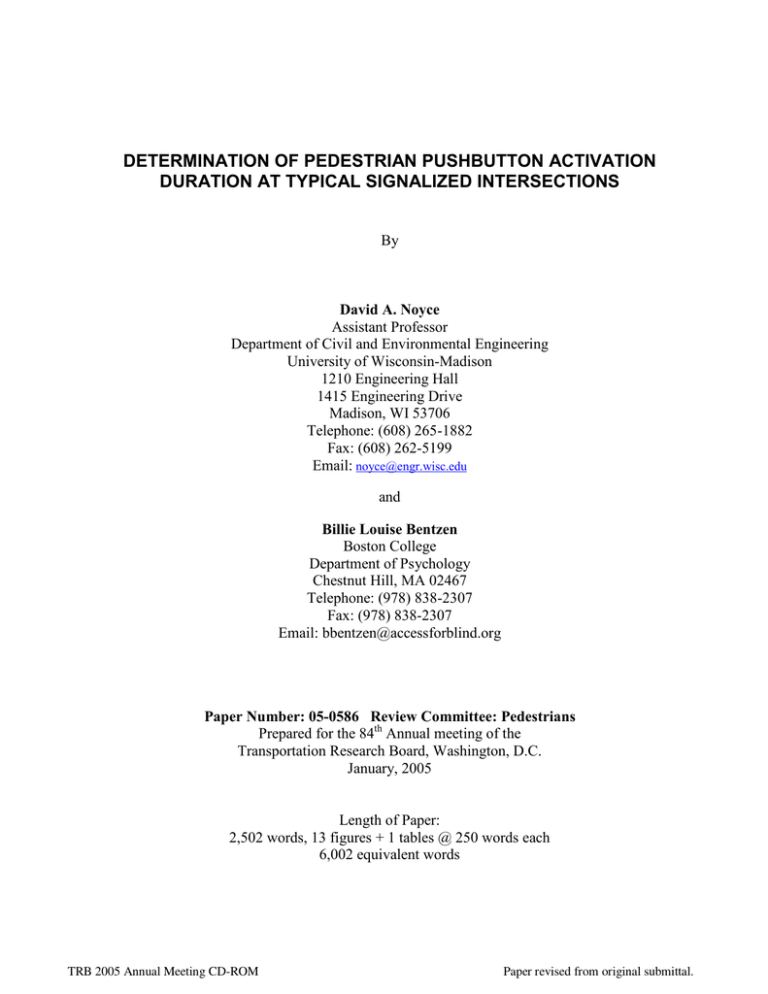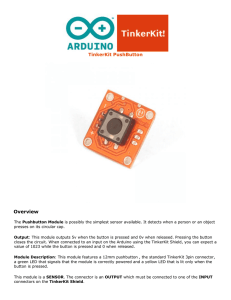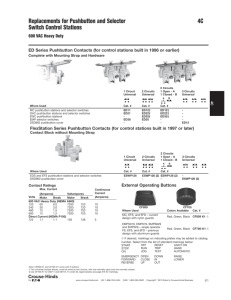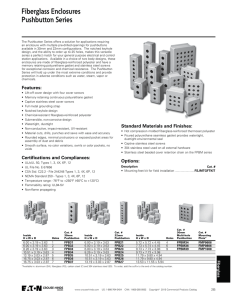Determination of Pedestrian Pushbutton Activation Duration at
advertisement

DETERMINATION OF PEDESTRIAN PUSHBUTTON ACTIVATION DURATION AT TYPICAL SIGNALIZED INTERSECTIONS By David A. Noyce Assistant Professor Department of Civil and Environmental Engineering University of Wisconsin-Madison 1210 Engineering Hall 1415 Engineering Drive Madison, WI 53706 Telephone: (608) 265-1882 Fax: (608) 262-5199 Email: noyce@engr.wisc.edu and Billie Louise Bentzen Boston College Department of Psychology Chestnut Hill, MA 02467 Telephone: (978) 838-2307 Fax: (978) 838-2307 Email: bbentzen@accessforblind.org Paper Number: 05-0586 Review Committee: Pedestrians Prepared for the 84th Annual meeting of the Transportation Research Board, Washington, D.C. January, 2005 Length of Paper: 2,502 words, 13 figures + 1 tables @ 250 words each 6,002 equivalent words TRB 2005 Annual Meeting CD-ROM Paper revised from original submittal. ABSTRACT Recent advances in pedestrian pushbutton design, led by the development of accessible pedestrian signals (APS), have created a new method of communicating traffic control information to pedestrians. Some APS devices have beaconing features and/or verbal (speech) message capabilities obtained by pressing and holding the pedestrian pushbutton for approximately three seconds. Other features, such as the extension of the walk interval, may also be activated with an extended pushbutton press. Recent research has suggested that three seconds may be excessive since holding the pushbutton this long is hard for some users. Additionally, most pedestrians may not hold the pushbutton for this length of time. The problem lies in determining how long the APS pushbutton should be pressed for a pushbutton information message and/or special accessibility features. The primary objective of this research was to develop a time distribution of typical pedestrian pushbutton activation durations. Data was obtained by attaching a voltage recorder to the pedestrian pushbutton circuit inside traffic signal controllers at eight locations, in three cities, in Wisconsin and Massachusetts. This device recorded the amount of time, to the nearest 1/100th of a second, that each pedestrian pushbutton was pressed. A total of 1,439 pushbutton presses were recorded. The average pushbutton press duration was 0.2 seconds. Over 95 percent of all pushbutton presses recorded were less than 1.0 seconds. Only four presses exceeded 3.0 seconds. The results show that the duration of an extended pushbutton press to obtain additional crossing information can be reduced to approximately one second without a significant number of false calls. A one second press will minimize the effort required for pedestrians to actuate special accessible features, while minimizing unnecessary noise and vehicular traffic disruption. Keywords: Pedestrian, Pushbutton, APS, Traffic Signal Controller, Detection, Blind TRB 2005 Annual Meeting CD-ROM Paper revised from original submittal. Noyce and Bentzen 1 INTRODUCTION The pushbutton detector is the common form of detection used for pedestrians. Located on a pole near the crosswalk, the detector is actuated by a pedestrian pressing the button. When the button is pressed, an electrical circuit opening takes place stopping a low-voltage current flow to the traffic signal controller and registering a call for pedestrian service. The circuit remains open for as long as the pushbutton is pressed. Once the initial call for service is made, the duration of the circuit opening or the number of additional button presses has no effect on controller operation. The Americans with Disabilities Act (ADA) of 1991, and recent ADA rulemaking, research, and technical assistance from the U.S. Access Board, along with TEA-21 legislation, provided the impetus for the development of advanced Accessible Pedestrian Signals (APS). APS is defined as a pedestrian pushbutton device that communicates information about pedestrian timing in a non-visual format such as audible tones, verbal messages, and/or vibrating surfaces. The Millennium Edition of the Manual on Uniform Traffic Control Devices was the first to incorporate standards for accessible pedestrian signals (APS) (1). Chapter 4E of the MUTCD, “Pedestrian Control Features” includes criteria for the implementation of APS devices into existing traffic signal systems. Information is provided on audible tones and verbal messages, vibrotactile features, pedestrian detectors, and pushbutton locations. Advanced APS devices on the market today consist of a pedestrian pushbutton containing audible and vibrotactile information coinciding with the illumination of the pedestrian WALK indication. The primary purpose of APS devices is to help pedestrians who are visually impaired to find the pushbutton and to advise precisely when the crossing interval begins. Figure 1 shows two different types of APS pushbutton devices currently used. Some of the newer APS technologies have special features that are actuated by an extended pushbutton press. A short (typical) pushbutton press actuates the pedestrian timing and visual, audible and vibrotactile WALK indications. An extended pushbutton press may actuate beaconing and/or verbal (speech) message capabilities, or extended pedestrian timing. Beaconing may consist of elevating the volume of the audible WALK signal and the locator tone, during the subsequent pedestrian phase. Both the locator tone and audible WALK signal are normally intended to be audible only six to twelve feet from the pushbutton or to the building line, whichever is less.(1) It may also consist of alternating the walk signal from one end of the crosswalk to the other, or presenting the WALK signal from the far end of the crosswalk only. A verbal message can be presented to the pedestrian under two conditions. A verbal message during the walk interval can indicate that the WALK signal is on to cross a named street. A verbal message during the flashing or steady DON’T WALK, called a pushbutton information message, can provide intersection identification information and information about unusual signalization or geometry at a particular crosswalk. Verbal messaging may also be used for other messaging, such as directions about a crossing closure and pedestrian detour. A controller can also be programmed to provide an extended pedestrian phase timing in response to an extended button press. With such a feature, the controller can regularly provide pedestrian timing that is the minimum permissible while allotting additional crossing time when needed by pedestrians who move or react slowly or who don't use visible cues and thus wait to confirm audible/vibrotactile cues before starting a crossing. In most advanced APS devices, these special features are actuated by pressing and holding the pedestrian pushbutton for approximately three seconds. APS pushbuttons are two-inch in diameter and require less than five pounds of force to activate making this extended push duration feasible. Other features, such as the extension of the walk interval, directions about a crossing TRB 2005 Annual Meeting CD-ROM Paper revised from original submittal. Noyce and Bentzen 2 closure and pedestrian detour, or a louder, beaconing, WALK signal can also be activated with this extended pushbutton press. The three second duration of the extended pushbutton press was not determined by research but selected by the original APS device manufacturers and has become a defacto industry standard. Nevertheless, recent research has suggested that three seconds may be excessive since holding the pushbutton this long is hard for some users (2). Additionally, it is believed that most pedestrians will not hold the pushbutton for this length of time. If the pedestrian who needs a special feature fails to hold the pushbutton long enough to get that feature, the effectiveness of the device is reduced and its purpose is not fulfilled. The problem lies in determining how long the APS pushbutton should be pressed to get special accessibility features. Ideally, obtaining the special features should require pushbutton activation duration longer that the time most pedestrians hold the pushbutton, but shorter than the time that a pedestrians with disabilities might find difficult (i.e., less than three seconds). Research is needed to determine the appropriate duration of a pushbutton activation to obtain the pushbutton information message and other special features that may be available in APS devices. OBJECTIVE The objective of this research was to develop a time distribution of ‘typical’ pedestrian pushbutton activation durations. Typical was defined as pushbutton press durations at non-APS pushbutton locations from a random selection of pedestrians who were not aware that their press durations were being measured and recorded. This information can be used to select the appropriate duration of the extended button press to actuate special APS features. STUDY DESIGN The study design to collect pushbutton duration data included the development of a device that was able to measure pushbutton duration through electronic means. To this end, a Monarch DC-1200 Two-Channel Voltage/Current Recorder was temporarily installed in a series of traffic signal controllers. This device recorded the amount of time, to the nearest 1/100th of a second, that voltage/current is active in a circuit. By attaching this device to the pedestrian pushbutton wire connections, inside the traffic signal controller cabinet, information pertaining to the duration of each pushbutton press was recorded. Figures 2 and 3 show the Monarch Voltage/Current Recorder and the signal cabinet installation procedure. An example of the output from the Monarch Voltage/Current Recorder is presented in Figure 4. Note that the device records a steady 24 volts DC current in the pedestrian circuit until a pushbutton is pressed. The National Electrical Contractor’s Association (NEMA) defines that the pedestrian call input into a traffic signal controller be normally at +24 volts DC when no calls are present and 0 volts DC when a call is active (3). However, some of the controllers evaluated used 12 volts AC instead of 24 volts DC. Regardless of the steady-state voltage used, voltage readings drop to 0 volts DC when a pushbutton is pressed, until the pushbutton is released. Since data is recorded every 1/100th seconds, an accurate estimate of the start and end time of the pushbutton press can be calculated. Data was collected at signalized intersections in the Boston, MA area and in Madison, WI. Intersections contained typical 3- and 4-leg geometry with moderate pedestrian volumes. Data was collected for 2 to 3 hours at each intersection selected. Data from all pushbuttons located at each intersection and wired into the traffic signal controller cabinet were recorded. Pedestrians were not aware of the data collection activities and were not observed during the data collection periods. Each intersection had a wide array of pedestrians in all age groups. Intersection locations included: TRB 2005 Annual Meeting CD-ROM Paper revised from original submittal. Noyce and Bentzen 3 • Main St/Elm St - Waltham, MA • Main St/Moody St - Waltham, MA • Nahatan St/Central St – Norwood, MA • Nahatan St/Washington St – Norwood, MA • Washington St/Railroad St – Norwood, MA • Babcock Dr/Campus Dr – Madison, WI (two applications) • Farley Ave/University Ave – Madison, WIDayton St/Randall Ave – Madison, WI Selected pictures of several intersection locations and pushbuttons considered in this research are presented in Figures 5 through 11. Note that both small (approximately 0.5-inch diameter) pushbuttons and large (2.0-inch diameter) pushbuttons were evaluated. Although small pushbuttons are not considered ‘accessible,’ both small and large pushbuttons were considered since many of each currently exist in the U.S. The force required to push each pushbutton was not specifically measured. Large pushbuttons were APS compliant and required less than five pounds of force to activate. Small pushbuttons were also estimated to require less than the five pounds of force for activation. The intersection of Babcock Drive and Campus Drive in Madison is a one-way Tintersection located on the University of Wisconsin campus with diverse pedestrian traffic in all directions. This intersection originally had a small pushbutton but was changed to a large pushbutton during the data collection process. Data were collected under both conditions. Given the fact that both pushbuttons existed and the demographic distribution of pedestrians was quite wide (children to older adults), a large amount of the data analyzed were collected at this location. All data were compiled and statistically analyzed to determine the distribution of pushbutton activation times. Descriptive statistics were computed and various percentile times determined. RESULTS The results from each data collection location are presented in Table 1. The number of observations ranged from 29 at Nahatan Street and Washington Street in Norwood, MA to 517 at Babcock Drive and Campus Drive in Madison, WI. A total of 1439 pushbutton presses were recorded. Pushbutton presses in Massachusetts were approximately 0.1 seconds longer on average than similar presses in Wisconsin, but this was not considered significant to the objectives of this analysis. Figure 12 presents the combined results from all eight data collection sites. The average (50th percentile) pushbutton press duration was 0.2 seconds. The range of durations recorded was from 0.02 seconds to 24.02 seconds. The percentile results were as follows: • • • • 75th percentile duration – 0.40 seconds 85th percentile duration – 0.56 seconds 90th percentile duration – 0.68 seconds 95th percentile duration – 0.98 seconds Only four of the 1439 pushbutton presses exceeded 3.0 seconds. The one pushbutton press of 24.02 seconds was not an erroneous data point but most likely from a pedestrian who felt that holding the pushbutton would expedite the next pedestrian WALK interval. Nevertheless, this data point was not used in the analysis. The next longest pushbutton durations were 7.2 seconds and 3.6 seconds. Each was included in the analysis. Over 95 percent of the pushbutton press durations TRB 2005 Annual Meeting CD-ROM Paper revised from original submittal. Noyce and Bentzen 4 were less than 1.0 seconds. Figure 13 provides a more detailed view of the pushbutton press durations between 0.0 and 1.0 seconds. There were only slight differences in pushbutton press durations between small and large pushbutton locations. The 95th percentile pushbutton press duration for small pushbuttons was 1.00 seconds compared to 0.90 seconds for large pushbutton locations. Average pushbutton press duration was 0.20 seconds with all pushbutton sizes. The Dayton Street and Randall Avenue location data found a 95th percentile duration of 0.68 seconds, lower than the small pushbutton sites. However, the Babcock Drive and Campus Drive site, where both small and large pushbuttons were evaluated, found the 95th percentile pushbutton duration for large pushbuttons to be 1.16 seconds, 0.24 seconds higher than small pushbuttons. Although these differences were statistically significant (p = 0.01), the magnitude of the difference was small and had no impact on the objectives of this research. CONCLUSIONS The results of this analysis found that 95 percent of the pushbutton presses recorded were less than 1.0 seconds in duration. This result would suggest that the length of the extended button press to actuate special accessibility features could be reduced from the current three seconds duration to one second without any significant changes in the frequency of unwanted special features. If this change was implemented within the data set evaluated, less than five percent of the pushbutton presses would have resulted in false calls. Although false calls are not desirable, they would not be detrimental to operations except in the rare occasion when an extended pushbutton press is used to request a longer pedestrian interval. In this case, some additional intersection delay may result. With a one second pushbutton press, false calls actuating beaconing would also only result in increased volume of the audible WALK signal on approximately five percent of the pushbutton presses. Alternatively, a required pushbutton press of 1.5 seconds for special features would still provide a significant reduction for the current three-second requirement and reduce false calls to approximately one percent. It is recommended that the Signal Technical Committee, Part of the National Committee on Uniform Traffic Control Devices, considers these results and recommends the appropriate changes in the MUTCD. REFERENCES 1. Manual on Uniform Traffic Control Devices (MUTCD). Millenium Edition. Federal Highway Administration (FHWA), Washington, D.C., 2000, http://mutcd.fhwa.dot.gov/. 2. Barlow, J.M., Bentzen, B.L., & Tabor, L.S. Accessible Pedestrian Signals: Synthesis and Guide to Best Practice. Draft Report. National Cooperative Highway Research Program, Project 3-62, January 2003. 3. National Electrical Manufacturers Association (NEMA). Traffic Controller Assemblies with NTCIP Requirements. NEMA Standards Publication TS 2-2003 v02.06, Rosslyn, VA, 2003. ACKNOWLEDGEMENTS This research was supported by the grant “Blind Pedestrians Access to Complex Intersections,” from the National Eye Institute, National Institutes of Health, #R01 EY128940-01 to Richard G. Long, Western Michigan University. This project could not have been completed successfully TRB 2005 Annual Meeting CD-ROM Paper revised from original submittal. Noyce and Bentzen 5 without the contribution of Mr. Joe Herr from VHB, Inc. in Watertown, MA. Joe provided a critical role in developing the Monarch Data Recorder as a device that was effective in recording pushbutton data in traffic signal cabinets. TRB 2005 Annual Meeting CD-ROM Paper revised from original submittal. Noyce and Bentzen 6 LIST OF TABLES AND FIGURES FIGURES Figure 1 – Two Different APS Pushbutton Devices. Figure 2 – Front Panel of Data Recorded Model 1200. Figure 3 – Field Testing of Cabinet Prior to Installation of Data Recorder. Figure 4 – Monarch Data Recorder Output Screen. Figure 5 – Nahatan Street at Central Street, Norwood, MA. Figure 6 – Main Street at Moody Street, Waltham, MA. Figure 7 – Babcock Drive at Campus Drive, Madison, WI. Figure 8 – Farley Avenue at University Avenue, Madison, WI. Figure 9 – Dayton Street at Randall Avenue, Madison, WI. Figure 10 – Typical Small Pedestrian Pushbuttons Used at Project Intersections. Figure 11 – Typical Large Pedestrian Pushbuttons Used at Project Intersections. Figure 12 – Combined Results of Pushbutton Press Durations. Figure 13 – Results of Pushbutton Press Durations – 0 to 1 Seconds TABLES Table 1 – Pushbutton Press Duration Results TRB 2005 Annual Meeting CD-ROM Paper revised from original submittal. Noyce and Bentzen 7 FIGURE 1 Two Different APS Pushbutton Devices. TRB 2005 Annual Meeting CD-ROM Paper revised from original submittal. Noyce and Bentzen 8 FIGURE 2 Front Panel of Data Recorder Model 1200. TRB 2005 Annual Meeting CD-ROM Paper revised from original submittal. Noyce and Bentzen 9 FIGURE 3 Field Testing of Cabinet Prior to Installation of Data Recorder. TRB 2005 Annual Meeting CD-ROM Paper revised from original submittal. Noyce and Bentzen 10 Scale – Volts DC x10 Pushbutton press 24 volts DC 0 volts DC Time and Date FIGURE 4 Monarch Data Recorder Output Screen. TRB 2005 Annual Meeting CD-ROM Paper revised from original submittal. Noyce and Bentzen 11 FIGURE 5 Nahatan Street at Central Street, Norwood, MA. TRB 2005 Annual Meeting CD-ROM Paper revised from original submittal. Noyce and Bentzen 12 FIGURE 6 Main Street at Moody Street, Waltham, MA. TRB 2005 Annual Meeting CD-ROM Paper revised from original submittal. Noyce and Bentzen 13 FIGURE 7 Babcock Drive at Campus Drive, Madison WI. TRB 2005 Annual Meeting CD-ROM Paper revised from original submittal. Noyce and Bentzen 14 FIGURE 8 Farley Avenue at University Avenue, Madison WI. TRB 2005 Annual Meeting CD-ROM Paper revised from original submittal. Noyce and Bentzen 15 FIGURE 9 Dayton Street at Randall Avenue, Madison WI. TRB 2005 Annual Meeting CD-ROM Paper revised from original submittal. Noyce and Bentzen 16 FIGURE 10 Typical Small Pedestrian Pushbuttons Used at Project Intersections. TRB 2005 Annual Meeting CD-ROM Paper revised from original submittal. Noyce and Bentzen 17 FIGURE 11 Typical Large Pedestrian Pushbuttons Used at Project Intersections. TRB 2005 Annual Meeting CD-ROM Paper revised from original submittal. Noyce and Bentzen 18 120 85th Percentile 100 95th Percentile Frequency 80 60 40 20 0 0.0 0.2 0.4 0.6 0.8 1.0 1.2 1.4 1.6 1.8 2.0 2.2 2.4 2.6 2.8 3.0 3.2 3.4 3.6 3.8 4.0 Pushbutton Press Duration (sec) FIGURE 12 Combined Results of Pushbutton Press Durations. TRB 2005 Annual Meeting CD-ROM Paper revised from original submittal. Noyce and Bentzen 19 120 100 85th Percentile Frequency 80 95th Percentile 60 40 20 0 0 0.1 0.2 0.3 0.4 0.5 0.6 0.7 0.8 0.9 1 Pushbutton Press Duration (sec) FIGURE 13 Results of Pushbutton Press Durations – 0 to 1 Seconds. TRB 2005 Annual Meeting CD-ROM Paper revised from original submittal. Noyce and Bentzen 20 TABLE 1 Pushbutton Press Duration Results Location Pushbutton Press Time (seconds) 85th 95th Low High Percentile Percentile Intersection City State Number of Observations Main St/Elm St Waltham MA 73 0.06 1.80 0.64 1.02 Main St/Moody St Waltham MA 72 0.02 3.40 0.58 1.08 Nahatan St/Central St Norwood MA 32 0.02 2.24 1.12 1.28 Nahatan St/Washington St Norwood MA 29 0.06 1.86 0.66 1.30 Washington St/Railroad St Norwood MA 47 0.08 0.70 0.52 0.70 Babcock Dr/Campus Dr Madison WI 443 0.02 1.00 0.50 0.92 Babcock Dr/Campus Dr (large pushbutton) Madison WI 517 0.02 3.12 0.64 1.16 Farley Ave/University Ave Madison WI 54 0.02 24.02 0.46 0.88 Dayton St/Randall Ave (large pushbutton) Madison WI 172 0.08 1.58 0.44 0.68 1439 --- --- 0.56 0.98 TOTAL TRB 2005 Annual Meeting CD-ROM Paper revised from original submittal.


